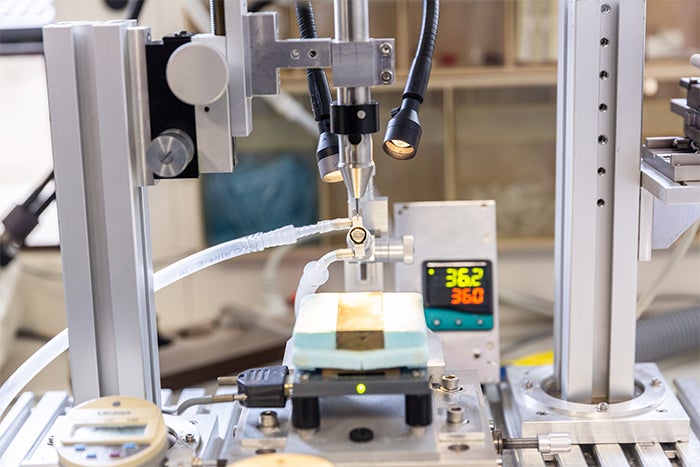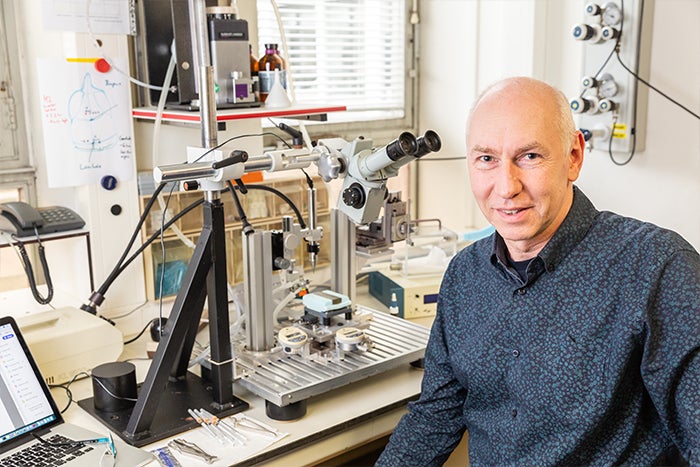Credential Oliver Stiedl
Stereotaxic System STS100Oliver Stiedl, chairman of the Animal Welfare Body of VU & VUmc at VU University Amsterdam about working with equipment of the electronic and mechanical department of the VU.
Equipment
I use the following equipment: (1) stereotactic system, (2) DualCage, (3) modified Barnes maze, (4) fear conditioning system refinements, (5) Figure-8 maze and many more experimental refinement.
Research
I use this for behavior studies in mice. The DualCage and the modified Barnes maze are novel (commercially unavailable) behavior tests that were essential for currently two publications and images are provided in the following papers:
- Finding the right motivation: Genotype-dependent differences in effective
reinforcements for spatial learning - GABAA receptor activation in the CA1 area of the dorsal hippocampus impairs consolidation of conditioned contextual fear in C57BL/6J mice
- Display of individuality in avoidance behavior and risk assessment of inbred mice
The electronics and mechanical departments
I approached the departments, because the commercial equipment does not offer the possibilities that we wanted to include in our research and therefore, we are happy, that the VU offers this possibility.
Description of the equipment
(1) System with heat pad for precise brain manipulations from cannula placement to viral vector injection of anesthetized mice
(2) Automated home cage-base fear learning assay for mice
(3) Refined spatial learning task for mice
(4) Establishment of a new commercially unavailable behavior system for mice expanding the DualCage
(5) Many small technical refinements over more than10 year,
Working of the equipment
(1) The system was improved over more than 10 years, has been adjusted to different needs and works very well.
(2) For this complex system a tight development of electronic and mechanic hardware lead to optimization of the system over more than 5 years with improvement along the development period due to experimental experience to work flawless in automated 24/7 behavior experiments.
(3) This task was newly developed and helped clarify important issues on the motivational contribution to spatial learning in two mouse strains.
(4) We are currently optimizing the setup for an upcoming research project.
(5) Many small refinements were helpful to improve the execution of many behavior experiments.
Improvements in the research
(1) It substantially improved the surgical conditions
(2) This development was essential to perform research addressing specific memory function under substantially different experimental conditions to come to novel conclusions concerning the translation value of this task.
(3) The same applies as under (2).
(4) We are hopeful to establish this as an assay to identify early effects in mouse models of the Alzheimer’s disease.
(5) These adaptations were helpful by saving time and/or improving precision in experiment.
Advantages over systems available on the market
(1) It improved the surgical conditions
(2) This is a unique system that is commercially available from a commercial partner that was also essential for the data acquisition and analysis side (biobserve.com). This system was essential to generate data on the behavior of mice without external influences (‘stress’), and thus, besides its scientific contribution also is an important animal welfare contribution.
(3) This is a unique system that may be copied by others but was essential to generate data on the behavior of mice without external influences (‘stress’), and thus, besides its scientific contribution also is an important animal welfare contribution.
(4) There is no equivalent commercial system available yet.
(5) Adequate customized components are commercially unavailable
Working with the electronics and mechanical departments
Overall, the interaction with the departments was essential for many technological developments and underscores the importance of these departments for research and development contributing to innovations for cutting edge science.
- The communication was always excellent.
- The support and suggestion were extremely helpfu
- The standard was generally excellent.
- The time to finish components was sometimes longer than expected/promise and hoped for.
Go to the productpage of Stereotaxic System STS100




More information
Precision Mechanics and Engineering Group
Joost Rosier
T +31 20 59 87439
E j.c.rosier@vu.nl
